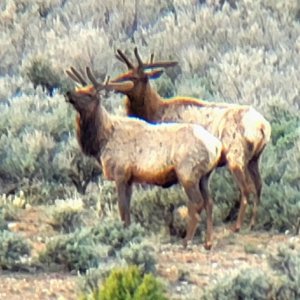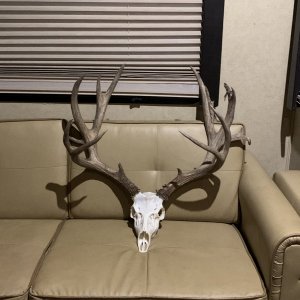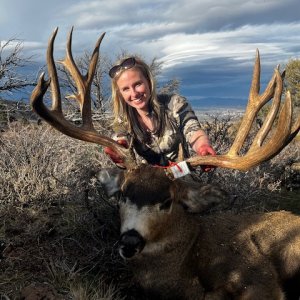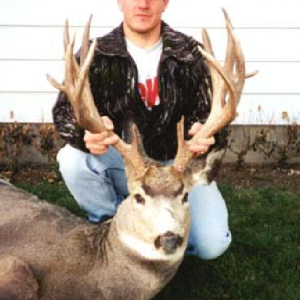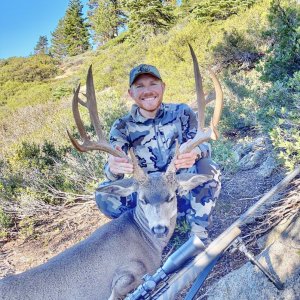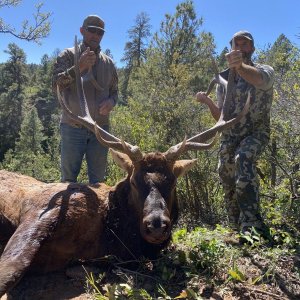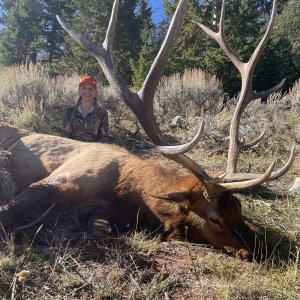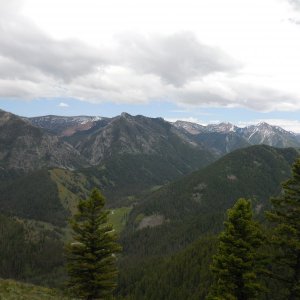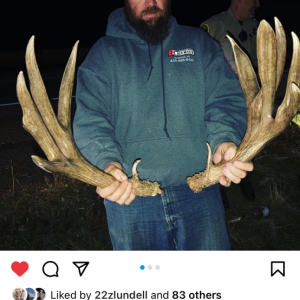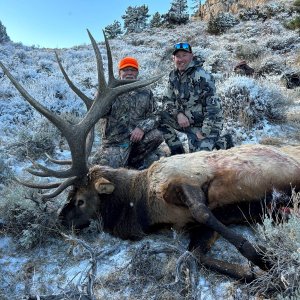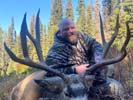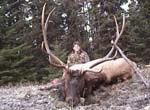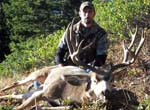muleybucks
Member
- Messages
- 7
To everyone who was concerned with this:
When this hunt "idea" was announed, I emailed my thoughts to Jon Rachel and Regan Berkley with Idaho Fish and Game. They were supposedly in charge of this and were referred to me as the "points of contact". The email was sent before the commissioner's meeting with hopes that they would reconsider the hunt. It did no good.
Below is my email to them, and secondly the reply I recieved from Regan Berkley. As is usually the case with Fish & Game (not always because there are some good eggs there), their response was horribly apathetic.
My email to them:
Please consider allowing hunters with regular season controlled antlerless tags from unit 39/43/44/45/48/52 which were previously unsuccessful, the first opportunity at the following hunt, if approved.
First off, as an avid mule deer hunter, I have seen our state?s mule deer quality and quantity diminish over the past 15 years. I understand the issues Fish and Game will face with the loss of winter habitat by this fire as well as the attempt to displace these animals. In truth, this likely needs to be done and having a hunt is likely the best way to accomplish this. I would support this hunt by either making it a ?youth or senior? opportunity given the relative ease of the hunt and the likeliness of finding animals on their winter grounds. If this isn't a youth/senior opportunity, please consider an archery or muzzleloader opportunity to decrease the ?effectiveness? compared with today?s modern rifles and their accuracy.
For the record, I greatly disagree with further reduction of our deer herds, especially on their winter grounds when we are normally being cautioned to ?leave deer alone? because they need to save valuable stored fat to make it through the winter. Now, we propose to run them around a bit (displace) being chased by hunters for another month during a critical time of year. This seems contradictory to their overall survival.
Here?s an idea: Set up a small feed site and every few days, use the net cannon on them, then strategically move the deer to places which have sustainable winter grounds rather than continue to take more deer. Also, consider adding a ?surcharge? to deer tags in the units from which these deer come to help pay for future winter ground restoration or feeding, rather than further reduction of the deer numbers. As a life-long Idaho resident and avid hunter, if things get any worse, I won't be buying tags in years to come.
__________________________
Regan's reply to me:
Thanks for your email regarding the proposed extra antlerless hunting opportunities in a portion of Unit 45. I think your idea of allowing hunters with controlled antlerless tags from the units you listed has a lot of merit. After all, many of the deer from those units winter in Unit 45. I think it would be difficult to administer from a couple of standpoints: first, many of the antlerless hunts you listed end the day before the first Unit 45 hunt begins, so hunters may not know whether they're successful or not until that date. Second, and perhaps more importantly, we rarely know whether a hunter has been successful until quite some time after their hunt, so contacting the unsuccessful hunters specifically would likely not be possible within the timeframe we're working under. As this is an extra tag, hunters who drew the hunts you listed are certainly eligible for those hunts (should they be approved), but I don't know that we have a way to grant preference to unsuccessful hunters from those units.
I appreciate your comments on reducing deer herds while simultaneously asking the public to reduce disturbance, and I agree that it can look like we are contradicting ourselves. However, I feel that both components you mentioned (some additional harvest, and minimizing winter disturbance) are important measures to take, and are not necessarily at odds with one another. The goal of additional harvest is to reduce the deer herd somewhat prior to winter, so that fewer deer are competing for the scarce resources remaining after a devastating fire. The Blair Fire burned almost 40,000 acres this August ? unfortunately, that 40,000 acres was one of the densest areas of wintering deer in Southern Idaho ? over 5,000 deer wintered in the burned area every year. This winter, they will undoubtedly try to find somewhere else to go. However, most of the nearby areas that still have forage are already pretty packed with deer during the winter. We expect that we will see higher than usual winter mortality this year, as some deer simply will not find an adequate alternative area to winter. Rather than incur all that additional mortality after those deer have competed for winter range, and eaten the scarce remaining forage all winter, we'd like to offer hunters the opportunity to harvest some prior to winter. Some additional harvest will also reduce the sheer numbers of deer that will potentially depredate nearby croplands or cause collision risks on the interstate.
We are also considering winter closures, to minimize disturbance. The goal of this is three-fold: 1.) we want to give the deer that head into winter the best possible chance of surviving, 2.) we want to provide secure ?refuge? areas for deer that are far from farmers? fields, and 3.) we want to provide secure areas that are far from most major roadways, including I-84.
You can already see we're hoping to work a fine balance here: we expect to see higher deer mortality this winter, but we'd like to minimize it as much as possible, while still aiming to keep the deer herd in balance with the available habitat, which unfortunately was just reduced by half.
As for feeding, it isn't off the table. However, we don't want to keep the deer herd artificially high in the face of a long recovery from this fire, so we'd like to avoid feeding if we can. If we keep the deer population high by feeding for a year or two, then stop feeding, we'll have even more deer in that area?.and we'll still be missing a huge chunk of winter range, as rehabilitation efforts will take a decade or more. This will compound some of the problems I described above ? few deer will get enough to eat during winter, depredations will increase, road and interstate mortality will become an even bigger concern. However, we will consider some strategic feeding if we begin to see serious problems down by the interstate.
This is going to be an adaptive process ? this year will teach us a lot about where the deer will go when they get to the burn and discover it's of no use to them, what mortality we might expect in coming years, how to structure harvest to help this deer herd recover as quickly as possible, in light of a major reduction in habitat. Please feel free to call me if you'd like to discuss this further.
Regan Berkley
Regional Wildlife Biologist
Magic Valley Region
324-4359
When this hunt "idea" was announed, I emailed my thoughts to Jon Rachel and Regan Berkley with Idaho Fish and Game. They were supposedly in charge of this and were referred to me as the "points of contact". The email was sent before the commissioner's meeting with hopes that they would reconsider the hunt. It did no good.
Below is my email to them, and secondly the reply I recieved from Regan Berkley. As is usually the case with Fish & Game (not always because there are some good eggs there), their response was horribly apathetic.
My email to them:
Please consider allowing hunters with regular season controlled antlerless tags from unit 39/43/44/45/48/52 which were previously unsuccessful, the first opportunity at the following hunt, if approved.
First off, as an avid mule deer hunter, I have seen our state?s mule deer quality and quantity diminish over the past 15 years. I understand the issues Fish and Game will face with the loss of winter habitat by this fire as well as the attempt to displace these animals. In truth, this likely needs to be done and having a hunt is likely the best way to accomplish this. I would support this hunt by either making it a ?youth or senior? opportunity given the relative ease of the hunt and the likeliness of finding animals on their winter grounds. If this isn't a youth/senior opportunity, please consider an archery or muzzleloader opportunity to decrease the ?effectiveness? compared with today?s modern rifles and their accuracy.
For the record, I greatly disagree with further reduction of our deer herds, especially on their winter grounds when we are normally being cautioned to ?leave deer alone? because they need to save valuable stored fat to make it through the winter. Now, we propose to run them around a bit (displace) being chased by hunters for another month during a critical time of year. This seems contradictory to their overall survival.
Here?s an idea: Set up a small feed site and every few days, use the net cannon on them, then strategically move the deer to places which have sustainable winter grounds rather than continue to take more deer. Also, consider adding a ?surcharge? to deer tags in the units from which these deer come to help pay for future winter ground restoration or feeding, rather than further reduction of the deer numbers. As a life-long Idaho resident and avid hunter, if things get any worse, I won't be buying tags in years to come.
__________________________
Regan's reply to me:
Thanks for your email regarding the proposed extra antlerless hunting opportunities in a portion of Unit 45. I think your idea of allowing hunters with controlled antlerless tags from the units you listed has a lot of merit. After all, many of the deer from those units winter in Unit 45. I think it would be difficult to administer from a couple of standpoints: first, many of the antlerless hunts you listed end the day before the first Unit 45 hunt begins, so hunters may not know whether they're successful or not until that date. Second, and perhaps more importantly, we rarely know whether a hunter has been successful until quite some time after their hunt, so contacting the unsuccessful hunters specifically would likely not be possible within the timeframe we're working under. As this is an extra tag, hunters who drew the hunts you listed are certainly eligible for those hunts (should they be approved), but I don't know that we have a way to grant preference to unsuccessful hunters from those units.
I appreciate your comments on reducing deer herds while simultaneously asking the public to reduce disturbance, and I agree that it can look like we are contradicting ourselves. However, I feel that both components you mentioned (some additional harvest, and minimizing winter disturbance) are important measures to take, and are not necessarily at odds with one another. The goal of additional harvest is to reduce the deer herd somewhat prior to winter, so that fewer deer are competing for the scarce resources remaining after a devastating fire. The Blair Fire burned almost 40,000 acres this August ? unfortunately, that 40,000 acres was one of the densest areas of wintering deer in Southern Idaho ? over 5,000 deer wintered in the burned area every year. This winter, they will undoubtedly try to find somewhere else to go. However, most of the nearby areas that still have forage are already pretty packed with deer during the winter. We expect that we will see higher than usual winter mortality this year, as some deer simply will not find an adequate alternative area to winter. Rather than incur all that additional mortality after those deer have competed for winter range, and eaten the scarce remaining forage all winter, we'd like to offer hunters the opportunity to harvest some prior to winter. Some additional harvest will also reduce the sheer numbers of deer that will potentially depredate nearby croplands or cause collision risks on the interstate.
We are also considering winter closures, to minimize disturbance. The goal of this is three-fold: 1.) we want to give the deer that head into winter the best possible chance of surviving, 2.) we want to provide secure ?refuge? areas for deer that are far from farmers? fields, and 3.) we want to provide secure areas that are far from most major roadways, including I-84.
You can already see we're hoping to work a fine balance here: we expect to see higher deer mortality this winter, but we'd like to minimize it as much as possible, while still aiming to keep the deer herd in balance with the available habitat, which unfortunately was just reduced by half.
As for feeding, it isn't off the table. However, we don't want to keep the deer herd artificially high in the face of a long recovery from this fire, so we'd like to avoid feeding if we can. If we keep the deer population high by feeding for a year or two, then stop feeding, we'll have even more deer in that area?.and we'll still be missing a huge chunk of winter range, as rehabilitation efforts will take a decade or more. This will compound some of the problems I described above ? few deer will get enough to eat during winter, depredations will increase, road and interstate mortality will become an even bigger concern. However, we will consider some strategic feeding if we begin to see serious problems down by the interstate.
This is going to be an adaptive process ? this year will teach us a lot about where the deer will go when they get to the burn and discover it's of no use to them, what mortality we might expect in coming years, how to structure harvest to help this deer herd recover as quickly as possible, in light of a major reduction in habitat. Please feel free to call me if you'd like to discuss this further.
Regan Berkley
Regional Wildlife Biologist
Magic Valley Region
324-4359

